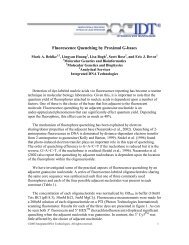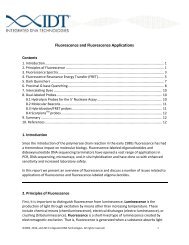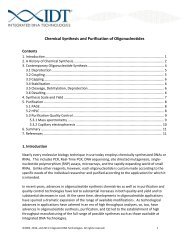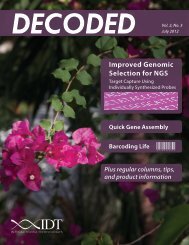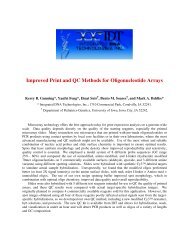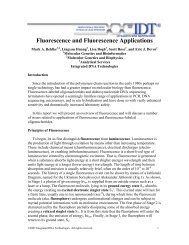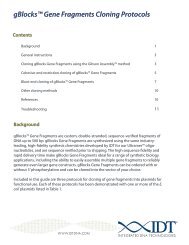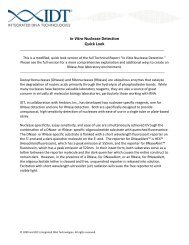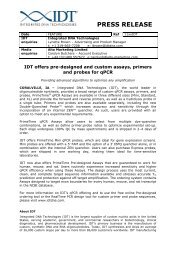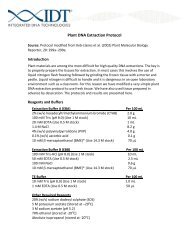Capillary Electrophoresis of Oligonucleotides - Integrated DNA ...
Capillary Electrophoresis of Oligonucleotides - Integrated DNA ...
Capillary Electrophoresis of Oligonucleotides - Integrated DNA ...
Create successful ePaper yourself
Turn your PDF publications into a flip-book with our unique Google optimized e-Paper software.
<strong>Capillary</strong> <strong>Electrophoresis</strong> <strong>of</strong> <strong>Oligonucleotides</strong><br />
Contents<br />
1. Introduction ................................................................................................................................ 1<br />
2. <strong>Capillary</strong> Gel <strong>Electrophoresis</strong> ...................................................................................................... 2<br />
3. Alternative Oligonucleotide QC Methods ................................................................................... 4<br />
4. CGE at IDT ................................................................................................................................... 5<br />
5. References .................................................................................................................................. 5<br />
1. Introduction<br />
<strong>Electrophoresis</strong>, operationally defined as the migration <strong>of</strong> analytes within an electrolyte<br />
solution under the influence <strong>of</strong> an electrical field, was first described by Tiselius in the 1930s<br />
[1]. Since its introduction, electrophoresis has become a primary tool <strong>of</strong> biochemical separation<br />
and has spawned numerous variants. One <strong>of</strong> those variants, capillary electrophoresis (CE)<br />
began in the 1960s as a technique for understanding ambiguities <strong>of</strong> the electrophoretic process<br />
itself [2]. In the method <strong>of</strong> zone electrophoresis, products <strong>of</strong> similar size are cleanly<br />
sequestered from those <strong>of</strong> other sizes; these areas <strong>of</strong> product are known as zones.<br />
Unfortunately, this method suffered from the phenomenon known as zone broadening in which<br />
the spaces between the product zones became blurred and the areas <strong>of</strong> product could not be<br />
cleanly resolved. The introduction <strong>of</strong> solid and semi-solid matrices for electrophoretic<br />
separation, such as paper and starch, relieved this problem to some extent. A major advance in<br />
the 1970s by Mikkers et al. was the use <strong>of</strong> narrow tubes made <strong>of</strong> chemically and electrically<br />
inert materials [3]. These tubes not only avoided the zone broadening problem but had the<br />
added advantage <strong>of</strong> compressing the distances between clearly defined zones well beyond the<br />
capabilities <strong>of</strong> other extant methods.<br />
Jorgenson and Lukacs improved on the use <strong>of</strong> inert tubes by pioneering open-ended glass<br />
capillaries [4]. Borrowing the concept <strong>of</strong> theoretical plates from chromatography [5], Jorgenson<br />
and Lukacs showed that separation efficiency in their capillaries could be expressed in terms <strong>of</strong><br />
the number <strong>of</strong> theoretical plates, N, in the form,<br />
N = V/2D (1)<br />
where is electrophoretic mobility, V is the applied voltage, and D is the molecular diffusion<br />
coefficient <strong>of</strong> the solute in the zone [6]. Since both and D are intrinsic properties <strong>of</strong> the solute,<br />
the implication <strong>of</strong> the result is that efficiencies depend entirely on voltage. Moreover, they<br />
found that, apart from run time, the length <strong>of</strong> the capillary had no effect on efficiency. Thus,<br />
©2005, 2010, and 2011 <strong>Integrated</strong> <strong>DNA</strong> Technologies, Inc. All rights reserved. 1
the best separation efficiencies were achieved at very high voltages in capillaries sufficiently<br />
long to dissipate the heat generated by the voltage [6].<br />
Once this foundation had been established, the method <strong>of</strong> capillary electrophoresis became a<br />
powerful and popular method for separating all types <strong>of</strong> biopolymers including proteins,<br />
peptides, and oligonucleotides [7]. The resolving capabilities <strong>of</strong> capillaries that reduced heating<br />
and allowed for extremely high electrical fields at once made the technique attractive for <strong>DNA</strong><br />
sequencing [8]. Aiding this application was the development <strong>of</strong> flexible, fused silica capillaries<br />
and an improved detector system [9, 10]. In 1993, a non-cross-linking polyacrylamide was<br />
developed that allowed for reuse <strong>of</strong> capillaries and the first high-resolution <strong>DNA</strong> sequences<br />
from a multi-use capillary/polymer system were reported in 1995 [11, 12].<br />
The technique <strong>of</strong> capillary gel electrophoresis (CGE) has also become an industry standard for<br />
assessing the purity <strong>of</strong> biochemical syntheses. Here, the application <strong>of</strong> CGE as a QC platform in<br />
the synthesis <strong>of</strong> oligonucleotides is presented.<br />
2. <strong>Capillary</strong> Gel <strong>Electrophoresis</strong><br />
The essence <strong>of</strong> CGE as a QC platform in oligonucleotide synthesis is the resolution <strong>of</strong><br />
polyacrylamide gel electrophoresis (PAGE) in a high throughput capillary format. PAGE is timeconsuming,<br />
labor intensive, requires relatively large amounts <strong>of</strong> sample material and, most<br />
importantly, does not supply accurate quantitative information about purity. In contrast, CGE is<br />
designed to deliver accurate quantitative information in an automated, high throughput<br />
environment.<br />
Very small volumes <strong>of</strong> sample (nanoliter amounts) are introduced into a fused silica capillary,<br />
with an inner diameter <strong>of</strong> 100 m, filled with a sieving matrix (gel) containing 7M urea. The<br />
capillary is heated to 30 o C which, along with the urea, denatures the oligonucleotide. In the<br />
presence <strong>of</strong> a high voltage electrical field the oligonucleotides migrate through the gel and the<br />
different species present in the injected sample are separated by size. As per equation (1) the<br />
resolving power <strong>of</strong> the capillary is determined by the voltage and, in contemporary systems,<br />
there is a potential for hundreds <strong>of</strong> distinct zones or, in chromatography terms, theoretical<br />
plates. An optical window is positioned 20 cm from the injection point and absorbance is<br />
measured at 254 nm as the zones migrate past the window. The optical density <strong>of</strong> each zone is<br />
plotted as a function <strong>of</strong> time in the capillary to create an electropherogram, or trace (Figure 1).<br />
Analysis <strong>of</strong> the CE optical density data begins by integrating the entire area <strong>of</strong> the trace that lies<br />
above the zero absorbance baseline. Oligonucleotide purity is simply the ratio <strong>of</strong> the area <strong>of</strong> the<br />
peak corresponding to the full-length synthesis product to the total area <strong>of</strong> the trace.<br />
As shown in Figure 1, the final, main, peak is the full-length synthesis product. The penultimate<br />
peak usually represents the population <strong>of</strong> products in which a single nucleotide is missing.<br />
These are, collectively, the n-1-mers. In theory, the missing base can occur anywhere in the<br />
©2005, 2010, and 2011 <strong>Integrated</strong> <strong>DNA</strong> Technologies, Inc. All rights reserved. 2
sequence except at the 3’-most base. This is because the 3’-most base is covalently attached to<br />
the solid synthesis support (the CPG). Since chemical reactions are never 100% efficient, there<br />
will always be a finite, non-zero probability that not all <strong>of</strong> the available couplings will occur at<br />
each step <strong>of</strong> the synthesis. The majority <strong>of</strong> these failed couplings are capped in order to prevent<br />
additional couplings to an incorrect sequence, but a small population <strong>of</strong> the growing oligonucleotides<br />
will remain reactive. The n-1 peak will lie immediately to the left <strong>of</strong> the main peak.<br />
Other peaks to the left are composed primarily <strong>of</strong> capped oligonucleotides from n-2 to n-(n-1).<br />
Occasionally, peaks will appear to the right <strong>of</strong> the main peak. Such peaks contain<br />
oligonucleotide species that were not completely deprotected, and so still contain an extra<br />
trityl group, or have extra bases and are (n + 1)-mers. These slower migrating entities may also<br />
be oligonucleotide aggregates that did not fully denature in the column, though this is rare.<br />
A.<br />
B.<br />
Figure 1. Output from a standard CGE analysis <strong>of</strong> an oligonucleotide synthesis.<br />
A. Plot <strong>of</strong> optical density in absorbance units (AU) versus time on column<br />
(minutes). In an oligonucleotide synthesis the final peak to come <strong>of</strong>f is the fulllength<br />
product and the penultimate peak is the n-1-mer peak. B. The numerical<br />
data corresponding to the trace. The total area <strong>of</strong> the trace above the baseline is<br />
1237312 (unitless). The area corresponding to the full-length product is 946312.<br />
Thus, the ratio is calculated as (946312)/(1237312) = 0.7648. After an internal<br />
mathematical correction factor is applied, the purity <strong>of</strong> the synthesis is reported<br />
as 73.48%.<br />
©2005, 2010, and 2011 <strong>Integrated</strong> <strong>DNA</strong> Technologies, Inc. All rights reserved. 3
The sensitivity that can be achieved by current CGE platforms is exemplified in Figure 2. Here, a<br />
40-mer oligonucleotide is assessed before and after polyacrylamide gel electrophoresis (PAGE).<br />
Even though the raw synthesis <strong>of</strong> the 40-mer is good, there are truncation products that<br />
require removal. Following PAGE purification, the CE shows that the vast majority <strong>of</strong> the mass<br />
<strong>of</strong> the (n-1) through n-(n-1) species has been removed.<br />
Figure 2. CGE traces <strong>of</strong> a 40-mer oligonucleotide before (left) and after (right)<br />
PAGE purification. While the non-full-length peaks have been significantly<br />
reduced, they have not been totally eliminated. Even so, the purity <strong>of</strong> the desired<br />
product has increased from less than 80% to greater than 95%.<br />
CGE is currently the accepted standard for assessing oligonucleotide purity. However, the data<br />
provided by a CGE analysis contains more information than just the ratio <strong>of</strong> the full-length<br />
product peak to the total. CGE trace data can be used to back-calculate average base coupling<br />
efficiencies for each synthesis if an unpurified oligonucleotide is analyzed. In addition, the<br />
length <strong>of</strong> an oligonucleotide can be estimated by CE using known size standards. For example,<br />
the size standard used by IDT is a purified 40-mer that is used to define a retention time for the<br />
capillary. For example, if the 40-mer standard has a retention time <strong>of</strong> 22 minutes and the<br />
average time between nucleotides is 0.2 minutes, then the retention time <strong>of</strong> a 20-mer will be<br />
22 – (20 x 0.2) = 18 minutes. Similarly, for a 70-mer, retention time is 22 + (30 x 0.2) = 28<br />
minutes. Such calculations are, <strong>of</strong> course, only rough estimates because retention times <strong>of</strong><br />
oligonucleotides <strong>of</strong> the same length will vary by specific nucleotide sequence. Thus, this<br />
method cannot be used to precisely determine the length <strong>of</strong> an oligonucleotide. However, it<br />
can be used to perform standardization checks on capillaries, gel matrix lots, etc.<br />
3. Alternative Oligonucleotide QC Methods<br />
Other methods can be used to test oligonucleotide purity. However, it is important to<br />
understand the limitations <strong>of</strong> these methods and how they compare to CGE. For example,<br />
©2005, 2010, and 2011 <strong>Integrated</strong> <strong>DNA</strong> Technologies, Inc. All rights reserved. 4
everse-phase HPLC (RP-HPLC), in which oligonucleotide species are separated on the basis <strong>of</strong><br />
hydrophobicity, is an excellent method for assessing the efficiency <strong>of</strong> tagging a hydrophobic<br />
ligand, such as a fluorescent dye or biotin group, onto an oligonucleotide. However, this<br />
method provides a poor assessment <strong>of</strong> purity. An oligonucleotide that appears to be 100% pure<br />
by RP-HPLC may be observed to be only 80% pure by CGE. Anion-exchange HPLC (IE-HPLC) is<br />
another method that can potentially provide information about purity but it does not perform<br />
any better than RP-HPLC in this capacity.<br />
Mass spectrometry (MS) is a method that is used to complement CGE. A CGE analysis <strong>of</strong> an<br />
oligonucleotide will provide an estimate <strong>of</strong> length and purity while the MS analysis provides the<br />
exact molecular weight (compound identity). Mass spectrometry will indicate the presence or<br />
absence <strong>of</strong> additional molecular species in the sample but these different species will ionize at<br />
different efficiencies. Thus, MS traces are not normally able to provide an accurate assessment<br />
<strong>of</strong> purity. In fact, it has been shown that there is no direct comparability between the size <strong>of</strong> an<br />
n-1 peak on a MALDI-TOF trace and the percentage <strong>of</strong> (n-1)-mer identified on a CGE trace <strong>of</strong> the<br />
same oligonucleotide sample.<br />
4. CGE at IDT<br />
The IDT High Throughput Analysis Department has the capacity to perform thousands <strong>of</strong> CGE<br />
analyses daily. At the present time we provide CGE on all oligonucleotides that have a purity<br />
guarantee (typically those shorter than 60 bases). Both CGE and MALDI-TOF QC results are<br />
available on the IDT web site.<br />
The minimum sample requirement for CGE analysis is 0.3 ODs <strong>of</strong> sample. This provides<br />
sufficient mass to carry out multiple runs if necessary. The best results are obtained if the<br />
oligonucleotide has been desalted because salt ions will compete with the oligonucleotide for<br />
entry into the capillary during electrokinetic injection. Also, CGE analyses carried out in salt<br />
buffers have characteristically rounded peaks with decreased resolution compared to analyses<br />
carried out in water.<br />
Finally, certain oligonucleotides will display anomalous migration in CGE. Secondary structures,<br />
such as hairpins, routinely behave anomalously in CGE. In such cases, the traces are forwarded<br />
to the IDT Technical Support Group. Members <strong>of</strong> the Technical Support Group provide<br />
assistance in interpreting non-standard CGE results.<br />
5. References<br />
1. Tiselius A. (1959) Introduction. in <strong>Electrophoresis</strong>: theory, methods, and applications, M.<br />
Bier, Editor. Academic Press: New York.<br />
©2005, 2010, and 2011 <strong>Integrated</strong> <strong>DNA</strong> Technologies, Inc. All rights reserved. 5
2. Hjerten S. (1967) Free zone electrophoresis. Chromatogr Rev, 9(2): 122 219.<br />
3. Mikkers FEP, Everaerts FM, and Verheggen TPEM. (1979) High-performance zone<br />
electrophoresis. J. Chromatogr, 169: 11 20.<br />
4. Jorgenson JW and Lukacs KD. (1981) Zone electrophoresis in open-tubular glass<br />
capillaries. Anal. Chem., 53(8): 1298 1302.<br />
5. Martin AJ and Synge RL. (1941) A new form <strong>of</strong> chromatogram employing two liquid<br />
phases: A theory <strong>of</strong> chromatography. 2. Application to the micro-determination <strong>of</strong> the<br />
higher monoamino-acids in proteins. Biochem J, 35(12): 1358 1368.<br />
6. Jorgenson JW and Lukacs KD. (1983) <strong>Capillary</strong> zone electrophoresis. Science, 222(4621):<br />
266 272.<br />
7. Kemp G. (1998) <strong>Capillary</strong> electrophoresis: a versatile family <strong>of</strong> analytical techniques.<br />
Biotechnol Appl Biochem, 27 (Pt 1): 9 17.<br />
8. Viovy JL and Duke T. (1993) <strong>DNA</strong> electrophoresis in polymer solutions: Ogston sieving,<br />
reptation and constraint release. <strong>Electrophoresis</strong>, 14(4): 322 329.<br />
9. Swerdlow H, Wu SL, et al. (1990) <strong>Capillary</strong> gel electrophoresis for <strong>DNA</strong> sequencing.<br />
Laser-induced fluorescence detection with the sheath flow cuvette. J Chromatogr,<br />
516(1): 61 67.<br />
10. Swerdlow H, Zhang JZ, et al. (1991) Three <strong>DNA</strong> sequencing methods using capillary gel<br />
electrophoresis and laser-induced fluorescence. Anal Chem, 63(24): 2835 2841.<br />
11. Ruiz-Martinez MC, Berka J, et al. (1993) <strong>DNA</strong> sequencing by capillary electrophoresis<br />
with replaceable linear polyacrylamide and laser-induced fluorescence detection. Anal<br />
Chem, 65(20): 2851 2858.<br />
12. Zhang J, Fang Y, et al. (1995) Use <strong>of</strong> non-cross-linked polyacrylamide for four-color <strong>DNA</strong><br />
sequencing by capillary electrophoresis separation <strong>of</strong> fragments up to 640 bases in<br />
length in two hours. Anal Chem, 67(24): 4589 93.<br />
©2005, 2010, and 2011 <strong>Integrated</strong> <strong>DNA</strong> Technologies, Inc. All rights reserved. 6



